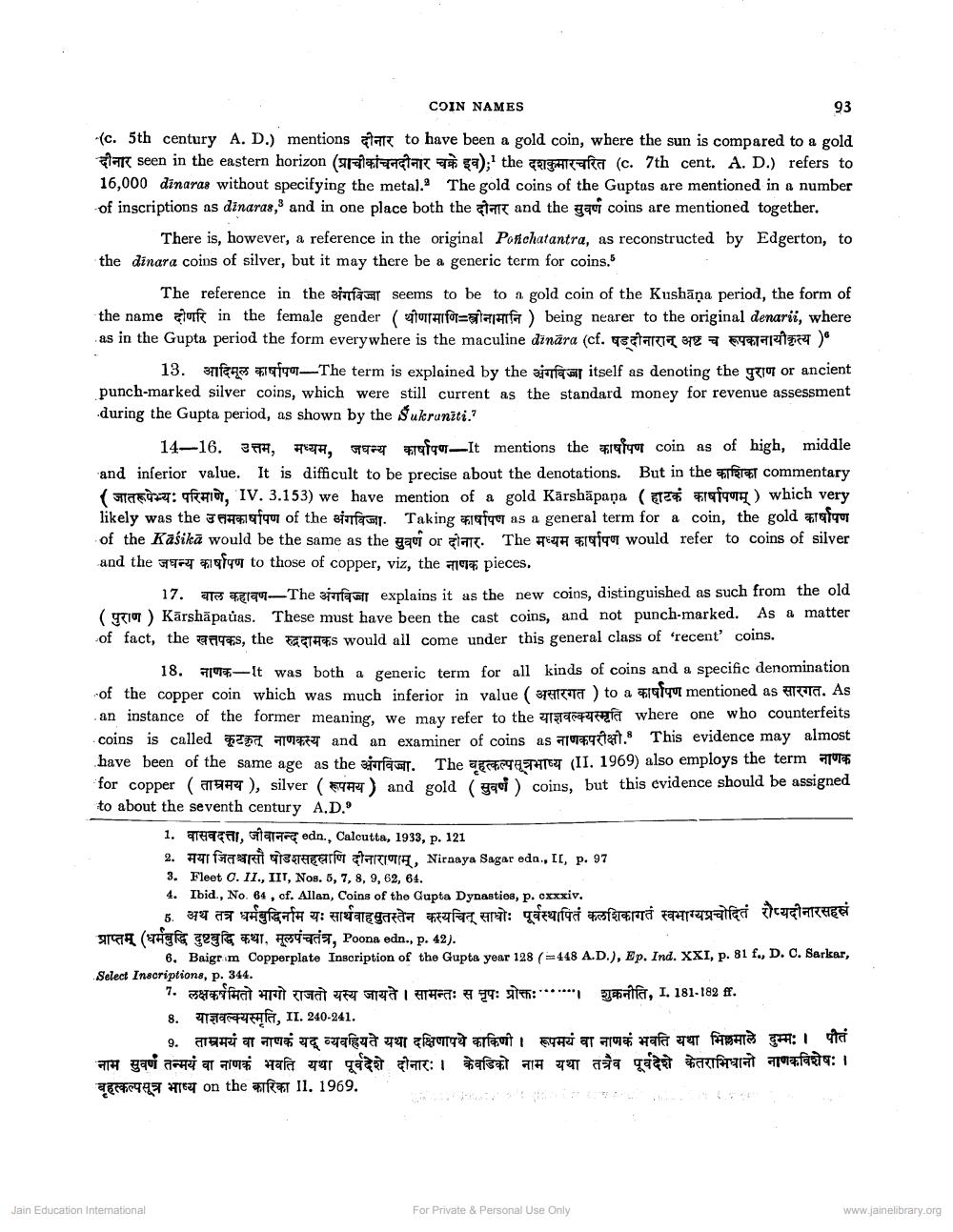________________
COIN NAMES
93 (c. 5th century A. D.) mentions at to have been a gold coin, where the sun is compared to a gold
are seen in the eastern horizon (alates a), the parafa (c. 7th cent. A. D.) refers to 16,000 dinaras without specifying the metal. The gold coins of the Guptas are mentioned in a number of inscriptions as dinaras, and in one place both the all and the gag coins are mentioned together.
There is, however, a reference in the original Porchatantra, as reconstructed by Edgerton, to the dinara coins of silver, but it may there be a generic term for coins.
The reference in the stitast seems to be to a gold coin of the Kushāņa period, the form of the name दोणरि in the female gender ( थीणामाणि-स्त्रीनामानि ) being nearer to the original denarii, where as in the Gupta period the form everywhere is the maculine dināra (cf. gegara BTE FYETUIT )
13. आदिमूल कार्षापण-The term is explained by the अंगविजा itself as denoting the पुराण or ancient punch-marked silver coins, which were still current as the standard money for revenue assessment during the Gupta period, as shown by the Sukrunīti.?
14-16. उत्तम, मध्यम, जघन्य कार्षापण-It mentions the कार्षापण coin as of high, middle and inferior value. It is difficult to be precise about the denotations. But in the Hilfarar commentary (FTERT: RAIO, IV. 3.153) we have mention of a gold Kārshāpaņa (T24 Fraft) which very likely was the उत्तमकार्षापण of the अंगविजा. Taking कार्षापण as a general term for a coin, the gold कार्षापण of the Kasika would be the same as the सुवर्ण or दोनार. The मध्यम कार्षापण would refer to coins of silver and the foot to those of copper, viz, the # pieces.
17. a 194—The Bilar explains it as the new coins, distinguished as such from the old (TTTKārshäpaủas. These must have been the cast coins, and not punch-marked. As a matter of fact, the 20th, the ETHES would all come under this general class of 'recent' coins.
18. 719-It was both a generic term for all kinds of coins and a specific denomination of the copper coin which was much inferior in value (Brac ) to a frattur mentioned as ara. As an instance of the former meaning, we may refer to the 1796 where one who counterfeits coins is called कूटकृतू नाणकस्य and an examiner of coins as नाणकपरीक्षो. This evidence may almost have been of the same age as the अंगविज्जा. The वहत्कल्पसूत्रभाध्य (II. 1969) also employs the term नाणक for copper (ATT), silver ( y and gold ( gal ) coins, but this evidence should be assigned to about the seventh century A.D.
1. arcai, 1907 edn., Calcutta, 1933, p. 121 2. ur fari agerfer RITHI, Nirnaya Sagar edo, II, p. 97 3. Fleet 0.11., IIT, Nos. 5, 7, 8, 9, 62, 64. 4. Ibid., No 64, of. Allan, Coins of the Gupta Dynasties, p. cxxxiv.
6. अथ तत्र धर्मबुद्धिर्नाम यः सार्थवाहमुतस्तेन कस्यचित् साधोः पूर्वस्थापितं कलशिकागतं स्वभाग्यप्रचोदितं रोप्यदीनारसहस्रं S1C7 (wgha gegn #41, Huaca, Poona edn., p. 42).
6. Baigrim Copperplate Inscription of the Gupta year 128 (448 A.D.), Ep. Ind. XXI, p. 81 f., D. C. Sarkar, Select Inscriptions, p. 344.
7. Hiftorit Tatay rai ura: 74: 14 ****** Jaafar, I. 181-182 ff. 8. 14 A , II. 240-241.
9. ताम्रमयं वा नाणकं यद् व्यवहियते यथा दक्षिणापथे काकिणी। रूपमयं वा नाणकं भवति यथा भिल्लमाले दुम्मः । पीतं नाम सुवर्ण तन्मयं वा नाणकं भवति यथा पूर्वदेशे दोनारः । केवडिको नाम यथा तत्रैव पूर्वदेशे केतराभिधानो नाणकविशेषः । ECF497 re on the afat Il. 1969.
Jain Education Intemational
For Private & Personal Use Only
www.jainelibrary.org




